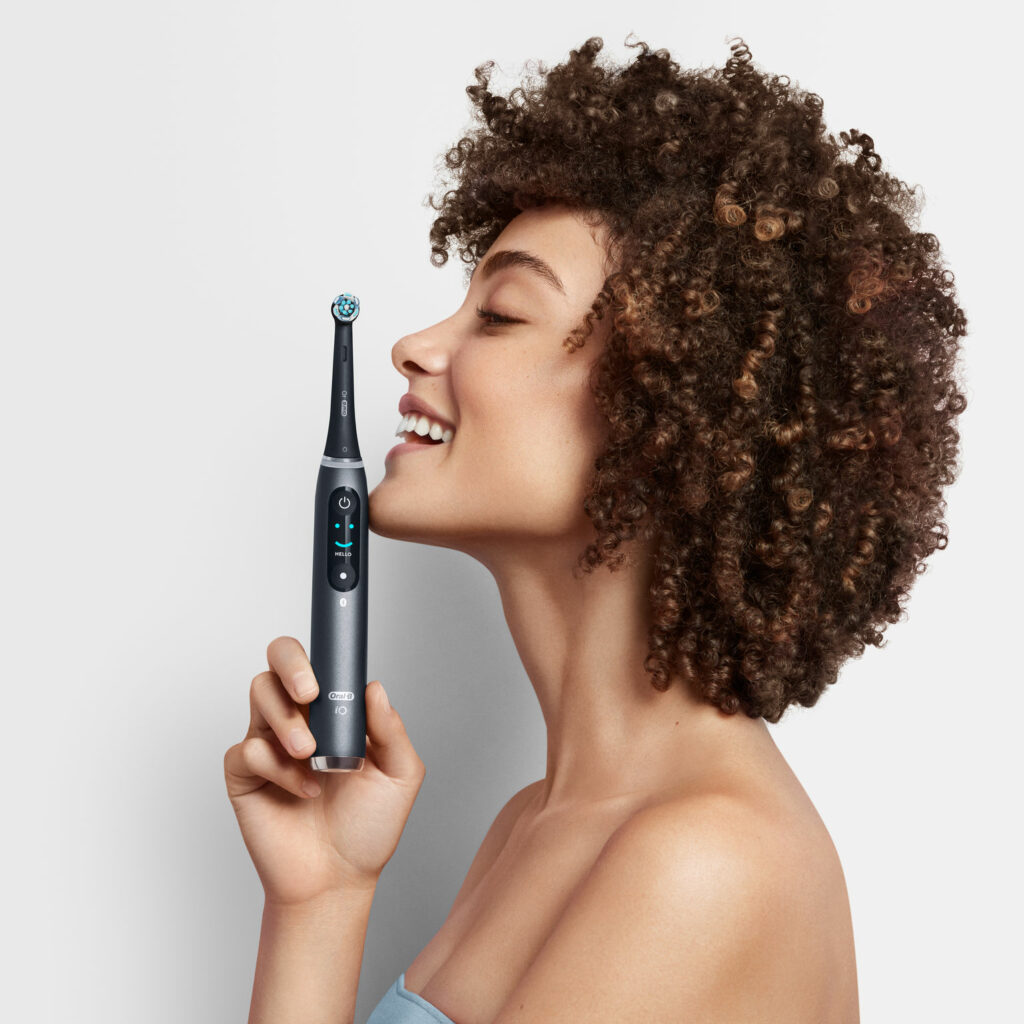When Oral B set out to revamp its electric toothbrush, it turned to its creative minds. The brief was straightforward: pack the toothbrush with new features to track brushing habits, monitor gum health, and even play music for its users. Yet, as the designers dove deeper, they stumbled upon an insight to pivot the project’s direction.
They observed that brushing teeth bordered on a ritualistic behaviour for many—more about comfort than complexity. The idea of layering on additional features didn’t just miss the mark; it risked amplifying users’ stress. In a bold move, the designers proposed a different route: simplify rather than complicate.
Their solutions?
Make the toothbrush easier to charge on the go and streamline the process for users to order replacement heads. Integrating these features with smartphone connectivity for timely reminders directly addressed real user needs without the frills. The designers created a daily companion that provides approachable personal coaching — Oral-B iO brushes, guides, and smiles.
The outcome? A pair of solutions that hit home because they resonated with what users wanted, not what the company thought they should want.

Photo Credit: iF Design
The case of Oral-B’s design innovation is a perfect example of how asking the right questions can lead to game-changing solutions. It’s fascinating to see how the designers shifted their focus from adding more features to simplifying the toothbrush’s usage and making it more convenient for users. By empathising with their customers and asking the right questions, they created a product that resonated with their needs and aspirations.
Asking questions is not just about gathering information; it’s about challenging assumptions, sparking curiosity, and navigating complex problem spaces. It’s a tool great designers use to transform vague ideas into tangible solutions.
Market research also plays a crucial role in the design-thinking process. It provides a broader context for the questions and validates assumptions about user behaviours and market trends. It helps designers create value-driven, user-centred products that fit seamlessly into users’ lives, answering their needs and easing their pains.
It’s easy to get caught up in the rush to deliver and forget the reflective, inquisitive phase of design thinking. However, asking the right questions is key to unlocking truly innovative solutions and staying ahead of the game.
Uncovering Opportunities through the Right Questions
Great designers are, at their core, great questioners. Questions are the compass that guides designers through innovation. By asking, “What if?” and “Why not?” they challenge the status quo and uncover paths less travelled. These questions prompt a deep dive into the user’s world, exposing pain points and desires that might not be immediately apparent. Market research provides a broader context for these questions. It helps validate assumptions about user behaviours and market trends, making the questions more targeted and the insights more actionable.
Understanding User Needs
Great designers do not presume to know what users want; instead, they ask. Through questions like, “How does this make you feel?” or “What challenges do you face in this task?” designers gather insights directly from the source. This empathetic approach to design thinking ensures innovative solutions resonate deeply with the user’s needs and aspirations.
Market research adds depth to this inquiry. Understanding market dynamics, competitor activities, and emerging trends can inspire more imaginative and market-responsive solutions.
Design is often mired in complexity, with multi-faceted problems and elusive solutions. Here, questions serve as the designer’s north star. Designers can navigate uncertainty by breaking complex issues into smaller, manageable questions. “What are the components of this problem?” or “Who is affected by this issue?” are examples of how questions can dissect a problem, making it easier to understand and tackle.
Challenging Assumptions and Sparking Curiosity
Assumptions are the silent killers of innovation, so one of the most powerful aspects of questions in the design process is their ability to challenge deeply held assumptions.
Questions act as a countermeasure, prompting designers and stakeholders to re-examine what they believe to be true. By asking, “Is this assumption valid?” or “Can we look at this from a different angle?” designers foster an environment where curiosity thrives and innovation flourishes.
In design, speed is often equated with efficiency. The ability to quickly iterate and launch products is a hallmark of success, a sentiment echoed by industry leaders like Uber Eats. However, this fast-paced environment can sometimes cast a shadow over one of the most critical aspects of the design process: deep questioning. The rush to deliver often sidelines the reflective, inquisitive phase of design thinking, leading to missed opportunities for truly innovative solutions.
IBM is a great example of a corporation that has heavily invested in design thinking and built a large internal design team. Their efforts have paid off as studies have shown that IBM has seen a 301% ROI by embracing design thinking.
Another impressive aspect of IBM is that they have made their enterprise design thinking assets available to everyone through an open toolkit.
The Pressure to Perform Quickly
Design teams are under constant pressure to move swiftly from concept to launch. This urgency is driven by competitive markets where being first can mean the difference between leading and following. In such an environment, spending time on extensive questioning might seem counterintuitive. The fear is that digging too deep could delay the project, allowing competitors to capture market share. This perception can discourage designers from engaging in thorough inquiry that uncovers profound insights.
There’s also a personal aspect to the hesitation in asking questions. Designers may worry about being perceived as obstacles in the process, especially in teams where the value of questioning is not fully recognised. The concern is that by probing too deeply, they might annoy colleagues or appear to doubt the team’s direction. This can create an environment where designers feel compelled to conform rather than challenge, stifling creativity and innovation.
UberEats: A Case Study in Valuing Deep Inquiry
Uber Eats offers a compelling example of how embracing deep questioning, even in a fast-paced environment, can lead to significant breakthroughs. Through its Walkabout Program, Uber Eats designers immerse themselves in the ecosystems of the cities they serve, going beyond surface-level observations to understand the unique challenges of food delivery in different locales. This commitment to understanding the nuances of food culture, infrastructure, and delivery logistics through direct observation and questioning has led to innovations like the driver app. By addressing the specific pain points of delivery partners, such as navigating parking in densely populated areas, Uber Eats has enhanced its service and stood out in a crowded market.

Photo credit: Liv By Design
The success of Uber Eats highlights a critical point: slowing down to ask the right questions doesn’t necessarily mean sacrificing speed or efficiency. Instead, it can lead to targeted solutions that address real user needs, creating a competitive advantage. It demonstrates the fear of deep questioning slowing down the process is often unfounded. Inquiry can streamline development by ensuring teams solve the right problems.
Types of Questions in Market Research and Design Thinking
In market research and design thinking, the questions can significantly influence the direction and depth of the insights gained. At the heart of this inquiry process are two primary questions: open-ended and closed. Understanding the nuances between these two can empower market researchers and designers to navigate the problem space more effectively, uncovering creative solutions and a deeper understanding of user needs.
Open-ended Questions
Open-ended questions are the bread and butter of the design thinking process. These questions are framed in a way that requires more than a yes-or-no answer, inviting respondents to share their thoughts, feelings, and experiences in detail. By their very nature, open-ended questions encourage exploration, reflection, and the expression of nuanced perspectives.
Examples of open-ended questions include:
- “How do you feel about the current process of food delivery?”
- “What challenges have you encountered when using our app?”
- “Can you describe a time when the service didn’t meet your expectations?”
These questions do not presuppose any specific answer, allowing for a wide range of responses. This openness is instrumental in uncovering hidden insights about user behaviors, needs, and frustrations. It’s the kind of questioning that leads to breakthroughs in understanding and innovation, allowing designers to dive deep into the problem space from the user’s viewpoint.
Closed Questions
Closed questions are designed to elicit a specific, concise response — typically “yes,” “no,” or another singular piece of information. While these questions are less conducive to exploring complex ideas, they are useful for gathering concrete data and clarifying specific details.
Examples of closed questions include:
- “Do you use our app daily?”
- “Is the current font size on the app comfortable to read?”
- “Did you find the checkout process to be straightforward?”
Closed questions can effectively narrow options, confirm hypotheses, or collect quantitative data. They provide clarity and precision but at the expense of depth and breadth in understanding.
The Power of Open-ended Questions in Unlocking Creativity and Deeper Understanding
Open-ended questions unlock creativity, deepen understanding of the market or design challenge, and encourage the exploration of new ideas. By exposing the design team to diverse user experiences and perspectives, these questions challenge assumptions and lead to innovative design solutions. Crafting a good question is essential for designers to empower stakeholders and foster an environment conducive to breakthrough thinking.
Here’s how good questions help the design thinking process:
Empowerment
Good questions empower those who answer them by giving them a voice in the design process. Empowering questions are open-ended, encouraging respondents to share their thoughts and experiences. These questions validate the respondent’s perspective, making them feel valued and understood.
Practical advice: Frame questions that put the user in control. Instead of asking, “Do you think this feature is useful?” consider asking, “How would you use this feature in your daily life?” This subtle shift emphasises the user’s agency and creativity, inviting them to co-create solutions.
Challenging Assumptions
A hallmark of a great question is its ability to challenge assumptions — both those held by the design team and by users themselves. By questioning the status quo, designers can uncover hidden biases and unearth innovative solutions that defy conventional wisdom.
Practical advice: Craft questions that directly confront assumptions. For instance, if the prevailing belief is that users want more features, you might ask, “What would make our app more useful to you if we could only add one feature?” This forces a reevaluation of the necessity of complexity in design.
Encouraging Breakthrough Thinking
Questions encouraging breakthrough thinking are designed to stretch the imagination and explore the possibilities. These questions often reframe the problem or present hypothetical scenarios that challenge users and designers to think outside the box.
Practical advice: Use speculative or hypothetical framing to spur creative responses. Questions like “Imagine it’s five years from now; how has your interaction with this product changed?” or “If time and money were no object, what would your ideal solution look like?” can unlock innovative thinking and visionary ideas.
Framing Questions for Maximum Impact
To frame questions that lead to impactful insights, consider the following guidelines:
- Be Specific Yet Open: Tailor your questions to be specific enough to guide the conversation but open enough to allow for unexpected insights. Avoid overly broad questions that can lead to vague answers.
- Create a Safe Space: Frame your questions in a way that makes it clear there are no wrong answers. This encourages openness and honesty.
- Encourage Storytelling: Use prompts that invite users to share stories, such as “Tell me about a time when…” This approach yields richer, more detailed insights.
- Seek the Why: Always look to understand the reasoning behind an answer. To dig deeper, follow up with questions like “Can you tell me more about why you feel that way?”.
- Avoid Leading Questions: Ensure your questions don’t imply a particular answer. This can skew responses and limit the discovery of genuine user needs and desires.
Creating an environment that encourages effective inquiry is crucial for unlocking the full potential of the market research and design thinking process.
Here are strategies to set the stage for asking questions that lead to impactful insights and innovative solutions.
| Strategy | Description | Specific Actions |
| Be a Continuous Learner | A mindset of continuous learning is essential for effective inquiry, emphasising curiosity, humility, and openness to learning. | – Remind yourself/team to learn from users- Embrace challenges to assumptions- View interactions as opportunities for deeper understanding |
| Find the Right People | Identifying and engaging with participants who represent the target user base is critical for insightful inquiry. | – Select participants with direct experience- Look for diverse perspectives- Include stakeholders and team members from different functions |
| Set the Context | Providing clear context at the beginning of a session helps participants understand the inquiry’s purpose and their role in it. | – Explain the project’s goals and what is hoped to be achieved- Clarify there are no right or wrong answers |
| Warm Up the Conversation | Starting with general or easy-to-answer questions helps make participants comfortable and open to deeper inquiry. | – Begin with broad questions about the participant’s background or experiences- Gradually lead into more specific or sensitive areas of inquiry |
| Create a Safe Space for Sharing | Ensuring participants feel safe and respected is paramount for effective inquiry, fostering an environment where they can share openly. | – Reinforce the importance of their contribution- Assure confidentiality of responses- Set ground rules for discussions in group settings |
| Asking the Right Questions | The ability to ask the right questions is crucial for uncovering underlying issues and facilitating innovative solutions that resonate with users. | – Employ strategies to uncover real needs beyond adding features- Identify and address the root cause of user dissatisfaction |
Asking the right questions is pivotal in uncovering users’ underlying issues, paving the way for innovative solutions that truly resonate. As previously mentioned, the case of Oral-B’s redesign serves as a prime example. By questioning the real needs of users rather than just adding features, the designers were able to identify and address the root cause of user dissatisfaction, leading to a product that better met their needs without unnecessary complexity. This inquiry process not only solves immediate problems but also opens up avenues for creative thinking and innovation.
Techniques to Trigger Imagination and Foster Creative Thinking
The Five Whys Technique: This involves asking “Why?” five times in succession to peel back the layers of a problem and get to the heart of an issue. It’s particularly effective in moving past symptoms and reaching the underlying cause. For instance, if users are not engaging with a feature, asking “Why?” repeatedly can uncover deeper issues related to usability or relevance that might not be immediately apparent.
Assumption Challenge: List all the assumptions about your product, service, or the problem you’re addressing. Then, systematically challenge these assumptions by asking, “What if the opposite were true?” This can lead to surprising insights and open up new possibilities for design and innovation.
Scenario Building: Use hypothetical scenarios to explore how users might interact with your product under different circumstances. Questions like, “How would someone use this product if they had never seen anything like it before?” or “What if this product were used in a completely different environment?” can spark imaginative solutions.
Analogous Experiences: Look outside your immediate design challenge to unrelated industries or products for inspiration. Asking, “How would a chef tackle this problem?” or “What can we learn from the gaming industry about engagement?” can bring fresh perspectives and innovative approaches to your design.
Question Starters to Foster Creative Thinking
| Question Starter | Purpose | Example |
| What if…? | Encourages exploration beyond current constraints to uncover unrestricted creativity. | What if our product could solve problems we haven’t even thought of yet? |
| How might we…? | Opens up the ideation space with a focus on collective problem-solving. | How might we make this experience more enjoyable for first-time users? |
| In what ways might…? | Provides a platform for exploring multiple angles and possibilities. | In what ways might we simplify this process to make it more intuitive? |
| If we knew…? | Prompts consideration of knowledge gaps and their potential impact on the design. | If we knew what makes users hesitate, how would that change our approach? |
| Why not…? | Challenges the status quo by questioning why certain approaches have not been attempted before. | Why not integrate social features directly into the app? |
Encouraging Collaboration Through Inquiry
The art of inquiry is not just about solving design problems; it’s a powerful catalyst for enhancing team dynamics, encouraging diverse viewpoints, and cultivating a rich culture of collaboration. By strategically using questions, teams can unlock a more inclusive, innovative, and cooperative work environment. Here’s how:
Strengthen Team Dynamics
Questions can level the playing field, allowing every team member to contribute their ideas and insights, regardless of their role or seniority. This inclusive approach fosters a sense of belonging and significance among team members, enhancing overall dynamics.
Example Questions for Strengthening Dynamics:
| Goal | Rationale | Example Questions |
| Strengthen Team Dynamics | Questions level the playing field, allowing all team members to contribute and fostering belonging and significance. | “What perspectives have we not considered?””How does this align with your experience or understanding?” |
| Encourage Diverse Viewpoints | Questions connect disparate viewpoints, harnessing collective intelligence to uncover unique solutions. | “Can someone with a different perspective share their thoughts on this?””How would you approach this problem from your area of expertise?” |
| Build a Culture of Collaboration | Questions stimulate a collaborative spirit, prompting team members to build on each other’s ideas for a greater outcome. | “How can we combine our ideas to create a better solution?””What can we learn from this approach to improve our own?” |
Implementing a Questioning Culture in Design Thinking
Embedding a culture of questioning within design teams and organisations can have profound implications. It’s a shift that moves beyond individual projects, leading to enhanced innovation, alignment, and team unity. A culture that values questioning and market research fosters an environment where innovation is guided by empathy and creativity and strategically aligned with market needs and opportunities.
Enhancing Innovation
A questioning culture encourages constant exploration and curiosity, fundamental to innovation. Organisations can ensure a steady flow of fresh ideas and creative solutions by fostering an environment where questions are welcomed and valued.
Benefits:
- A curiosity-fueled approach to problem-solving drives continuous innovation.
- A resilient mindset that thrives on challenges and change.
Promoting Alignment and Clarity
Questions help clarify goals, expectations, and strategies, ensuring everyone is on the same page. This clarity is essential for effective collaboration and decision-making, reducing misunderstandings and misalignments that can derail projects.
Benefits:
- Enhanced communication and understanding across teams and departments.
- More efficient and focused efforts towards common objectives.
Fostering Team Unity
A culture that values questioning is inherently inclusive, recognising the importance of every team member’s input. This inclusivity strengthens relationships, builds trust, and promotes a sense of unity and commitment towards shared goals.
Benefits:
- Stronger, more cohesive teams that are equipped to tackle complex challenges.
- An environment where individuals feel valued and motivated to contribute.
| Focus Area | Description | Benefits |
| Enhancing Innovation | Fostering an environment where questions are welcomed and valued, encouraging exploration and curiosity fundamental to innovation. | – Continuous innovation driven by a curiosity-fueled approach to problem-solving.- Resilient mindset thriving on challenges and change. |
| Promoting Alignment and Clarity | Using questions to clarify goals, expectations, and strategies, ensuring everyone is aligned. This clarity supports effective collaboration and decision-making. | – Enhanced communication and understanding across teams.- More efficient efforts towards common objectives with reduced misunderstandings. |
| Fostering Team Unity | Creating an inclusive culture that values every team member’s input, strengthening relationships, building trust, and promoting unity towards shared goals. | – Stronger, cohesive teams capable of tackling complex challenges.- An environment where individuals feel valued and mot |
Here are three refined strategies that highlight the importance of market research in enriching your design thinking practices:
Combine Empathy Workshops with Market Research Insights: Elevate your empathy-building activities by incorporating findings from market research. Use detailed persona building and user journey mapping alongside market segmentation, competitive analysis, and trend forecasting. This approach ensures a well-rounded understanding of the user’s environment, preferences, and behaviours.
Enrich Ideation Sessions with Market Insights
Integrate market research data to inform and inspire the creative process when facilitating ideation sessions. Utilise insights into consumer trends, market gaps, and competitor innovations to spark ideas that are not only creative but also strategically aligned with market opportunities. Encourage the team to use this data as a springboard for generating innovative and viable solutions in the current market. This ensures your ideation process is grounded in reality and geared toward creating value in the marketplace.
Leverage Rapid Prototyping and Feedback Loops with Market Validation:
Enhance your rapid prototyping efforts by incorporating market validation processes. Alongside user feedback, conduct targeted market research to test your prototypes’ broader appeal and potential impact. Use surveys, focus groups, and A/B testing to gauge market receptivity, identify potential barriers to adoption, and understand the competitive context. This integrated approach not only refines the product based on user feedback but also ensures its market feasibility and scalability.
Final Thoughts: Integrating Market Research in Design Thinking
A crucial takeaway emerges: integrating market research at every stage, from empathy to testing, is not just beneficial—it’s transformative. This synergy between market insights and design thinking enhances the depth, relevance, and impact of our design solutions, ensuring they meet user needs and align with market dynamics.
Empathy Stage: At the outset, market research enriches our understanding of the target audience, going beyond individual user experiences to encompass broader consumer trends, preferences, and behaviours. This wider lens helps us craft more nuanced personas and empathy maps, ensuring our solutions are grounded in a comprehensive view of the user within their market context.
Define Stage: Market insights are pivotal in defining the problem space. They help validate the problems identified through user research, ensuring they are really significant for the users and relevant from a market perspective. This validation is key to focusing our efforts on challenges worth solving, both from a user and a business standpoint.
Ideate Stage: Here, market research injects a dose of reality into our creative brainstorming. It provides a backdrop of competitive analysis, trend forecasting, and market gaps, guiding ideation toward solutions that are not only innovative but also viable and differentiated in the marketplace. This strategic alignment ensures our creative energy is channelled into ideas with the potential for real-world impact.
Prototype Stage: Market research helps us anticipate and incorporate market reactions and preferences as prototypes take shape. This foresight allows for the refinement of prototypes with a clear understanding of market standards, user expectations, and competitive benchmarks, making each iteration more market-ready.
Test Stage: Finally, integrating market research into the testing phase enables us to evaluate our solutions against market criteria beyond user feedback. This includes assessing market fit, scalability, and potential barriers to entry, ensuring our tested solution is desirable for users and strategically positioned for success in the market.
Practical Ways to Incorporate Market Insights:
- Regularly review and analyze market reports and trend analyses as part of project kick-offs and strategy sessions.
- Include competitive analysis in your research phase to understand where your solution stands in the market landscape.
- Use market segmentation data to refine personas and ensure they reflect broader market dynamics.
- Incorporate market validation tests alongside user testing, using tools like surveys, focus groups, and A/B testing to gauge broader market reception.
Integrating market research into the design thinking process ensures our solutions are user-centred, creative, and strategically aligned with market needs and opportunities. This holistic approach amplifies our design solutions’ effectiveness and market relevance, setting the stage for innovation that resonates, differentiates, and succeeds.



 Senior Marketing Executive
Senior Marketing Executive Sales & Marketing
Sales & Marketing General Manager PR -Internal Communications & Government Affairs
General Manager PR -Internal Communications & Government Affairs Vital Strategies
Vital Strategies
 Customer Intelligence Director
Customer Intelligence Director